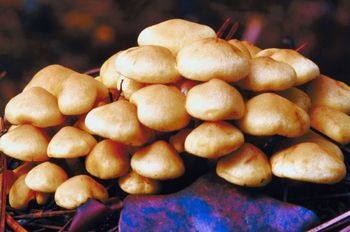How to Grow Mushrooms
Growing mushrooms is a common hobby for amateur agriculturalists and mycologists alike. Mushrooms are unique among other garden “plants”, since they are fungi and not in the plant family. According to a consensus of scientists, mushrooms are more closely related to animals than plants, though the mushroom we eat is the fruit of a fungus, much like an apple is the fruit of an apple tree.
Learning how to grow mushrooms lets you grow your own supply to be harvested and eaten at the dinner table. Also, learning how to grow mushrooms let’s you consume fresher than store-bought mushrooms, which you don’t have to hunt for in the wild. Getting wild mushrooms is time consuming and won’t yield the amount of mushrooms you need to cook your dish of choice.
So plant mushrooms next to your fruits and vegetables and have a steady supply of shrooms in your backyard or, more likely, your basement or cellar.
Which Mushrooms Dangerous to Eat?
Another reason people learn how to grow mushrooms or buy them at the store is that it’s dangerous to gather them from the wild. There are a variety of mushrooms that grow naturally in the wild, but many of them are poisonous. Most professionals recommend that only a seasoned expert attempt to gather their own mushrooms in the wild.
Even with the help of a guide book, mistakes can happen. Illustrations might not conform to the exact details of a particular mushroom growing in the wild, so a visual mistake can be made by the untrained eye. While some inedible mushrooms might just make you sick, other mushrooms are poisonous enough to kill a person who eats them – sometimes within minutes of consumption.
Mushroom FAQ’s
Many mushroom growers grow their mushrooms indoors, instead of in a garden outside. That’s because mushrooms are fungi that thrive in damp, humid and dark environments. The three most common types of mushrooms purchased for home growth are shiitake mushrooms, oyster mushrooms and white button mushrooms.
Even among the fungus kingdom, different mushrooms thrive in different environments. Hard wood or hard wood sawdust is best when growing shiitake mushrooms, while oyster mushrooms require straw. White button mushrooms are best grown on composted manure.
Buying Mushroom Spores

How to Grow Mushrooms
When you decide which mushroom type you want to grow, you need to seek out the purchase of spores from a reputable dealer. Many people purchase their mushroom spores online. However, if you live near a greenhouse or agricultural outlet, you can also buy them in person.
Although the base soil on which fungi grow and the spores are different from each other, the basic method for mushroom growth is standard throughout all the species of mushrooms. You want to find a cool, damp and dark area somewhere in or around your home to grow mushrooms.
Basements are prime real estate for fungi fruition, but you can also use an empty closet or cabinet, as long as you have a way of keeping the environment within hospitable for your crop. You can do this by purchasing a humidifier. Depending on the company, you should be able to obtain a humidifier that meets the size and space requirements of your growing area.
Growth and Humidity Concerns
Along with darkness and moisture, you need a source of heat to grow mushrooms. Your best bet is an oven or hotplate. Raise the temperate of your growth base to 70F, after placing it into the bed of a pan. Wait 3 weeks and the spores should root their filaments into the growing medium.
Once this happens, reduce the temperature to around 60F or 55F. Cover the rooted spores with about an inch of soil. Cover the soil and pan with a damp cloth and keep the cloth wet by spraying it as it begins to dry.
Prevent Dryness
Lift the cloth and spritz the soil to prevent it from becoming too dry for mushroom growth. Mushroom blooming occurs in about 3 or 4 weeks. Wait to harvest the mushrooms until the cap or top part has completely bloomed, so that it separates from the stem or base.
When this occurs, you’re ready to pick the mushrooms, though you have the option to pick them after they grow larger, by nurturing the mushrooms longer.
After you harvest your first homegrown batch of mushrooms, you can experiment by expanding your operation and growing different varieties of mushrooms. Use separate pans if you plan on growing simultaneous different species of mushrooms, as mixing growth bases can ruin the fruitful harvest.
If you are fortunate to have a damp and dark basement, invest in the equipment to start a more large-scale operation than afforded by a simple closet or cupboard. If you are ambitious enough, you can start several pans growing at once and cycle them to be harvested constantly, by staggering the initial planting and harvesting times. This way, you can have a constant stream of mushrooms to harvest and even sell to your friends.
When you have so many mushrooms to go around, looking for new and exciting mushroom recipes is the next step. There are a million great mushroom recipes you’ll want to try, now that you know how to grow mushrooms.
